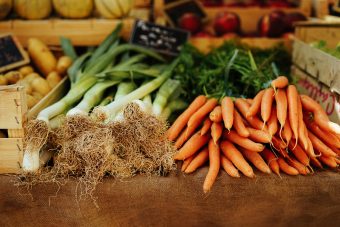Last week, Governor Andrew Cuomo and the New York State Legislature reached agreement on one of the most pro-environmental budget sessions in many years.

Not surprisingly, Albany’s agreement on a new comprehensive congestion pricing plan and a new law to ban plastic bags grabbed top headlines in the press.
But along with the excitement on these important bills is another environmental victory worthy of celebration—a first-of-its-kind food waste bill that will help direct more healthy food to disadvantaged New Yorkers while also slashing climate pollution around the state. With this new law, New York becomes one of the largest states in the country to develop a powerful mandate around food waste.
The Food Donation and Food Scrap Recycling Act (the Act) is a monumental step forward in New York for preventing food waste, rescuing surplus wholesome food for those in need, and recycling any remaining food scraps.
Why is food waste so important?
Overall, 40 percent of food in this country is wasted. At the same time, nearly 2.5 million New Yorkers struggle to have enough to eat.
Food also makes up 18 percent of our solid waste stream. The vast majority of this food is disposed of in landfills where it breaks down and releases methane, a potent greenhouse gas.
Further, when we waste food, we waste all the energy, water, and labor it takes to get that food on our plates. In fact, if global food waste were a country, it would be the third largest emitter of greenhouse gases after the United States and China.
So, how does this Act tackle the issue of food waste?
In short, the Act requires the largest generators of food waste across the state to separate any excess wholesome food for donation and recycle any remaining food scraps. This is a new mandate across the state and the New York State Department of Environmental Conservation estimates it could keep more than 250,000 tons of food out of landfills each year.
More specifically, the Act contains three important provisions:
First, the Act codifies the food waste hierarchy as part of state law. For the first time, this sets up a framework to address this pressing issue across the state.
At the top of the hierarchy, we want to prevent excess food from being grown in the first place—this is the most powerful way to save all of the land, water, and energy that go into growing our food.
Next, if there is still excess food, we want to rescue any wholesome food for those in need. Too often, food is thrown out that could feed those in our community who struggle to have enough to eat.
Any remaining food or food scraps should be recycled (through composting or anaerobic digestion) to keep them out of landfills and to return their valuable nutrients to the soil.
Second, to advance the rescue part of the hierarchy, the Act requires the largest generators of food waste—those generating more than 2 tons a week, like grocery stores, colleges and restaurants—to separate wholesome food for donation to food rescue organizations. They are also required to report to the state the amount of food they donate each year.
This cutting-edge requirement should begin to make food donation the norm instead of the exception. Many grocery stores and others already donate food into their community, but many still do not. This mandate will ensure that large generators work to donate excess food and increase the food available to food rescue organizations.
Third, with respect to the recycling tier of the hierarchy, the Act requires these same large generators to recycle any remaining food scraps instead of sending it to landfills. This requirement only applies, however, if they are located within 25 miles of a food scrap recycler (compost or anaerobic digestion facility) with capacity.
New York is one of the largest states in the country to develop this kind of powerful mandate. For the first time, we will begin to sustainably manage our food waste on a statewide basis.
The Act does not apply to New York City, which enacted its own food scrap recycling law in 2013. See my colleague Eric Goldstein’s blog for background on that New York City law.
In sum, with the passage of the Food Donation and Food Scrap Recycling Act, New York can begin to get better food to our neighbors in need, cut climate emissions, and rebuild our soils. NRDC is pleased the State has taken a leading role in this issue which is so central to a safe climate and healthy New Yorkers.
Author: Margaret Brown
Source: NRDC

